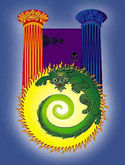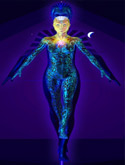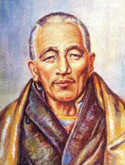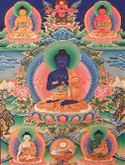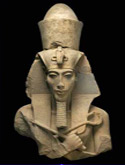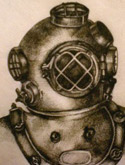The three ‘gunas’ are the three qualities of matter itself, sattva, raja and tamas, or rhythm, activity and inertia, and are inherent in all forms. The student needs to remember that every form on every plane is thus characterised, and this is true of the highest form as of the lowest, the manifestation of these qualities only differing in degree.
Speaking generally it might be said that:
1) The attribute of inertia (or tamas) characterises the lower personal self, the sheaths of the threefold lower man.
2) The attribute of activity is the prime characteristic of the soul, and it is this quality which causes the intense activity and constant labour of the man as he seeks experience and later, as he seeks to serve.
3) The attribute of rhythm, or balance, is the quality of Spirit or Monad and it is this tendency to perfection which is the cause of man’s evolution in time and space and the factor which carries all life through all forms to the consummation. Let us bear in mind here, however, that these three qualities are the qualities of substance through which the triple spirit is manifesting in this solar system.
Coming to the practical manifestation of the gunas in the three worlds (in relation to man) it can be noted that:
1) The attribute of balance or rhythm (sattva) distinguishes the mental vehicle.
2) The quality of activity or mobility (raja) is the characteristic of the emotional or astral nature.
3) Inertia (tamas) is the quality dominating the physical body and the whole objective of the ego is to break down that inertia and drive it’s lowest vehicle into an activity that will bring about the desired ends. (Sutra 15, Book II)
The gunas are the three qualities of matter, the three effects produced when macrocosmic energy, the life of God which persists independently of form-taking, actuates or energises substance. The three gunas are:
| Sattva |
Energy of |
Father |
rhythm or harmonious vibration |
|
Rajas |
Energy of Soul
Ego |
Son |
mobility or activity |
|
Tamas |
Energy of Matter
Personality |
Holy Ghost |
inertia |
These three correspond to the quality of each of the three aspects which express the one Life. (Sutra 16, Book I – Light of the Soul.)
The Qualities of Rotary Motion
Every rotating sphere of matter is characterised by the three qualities inertia, mobility and rhythm ie. tamas, rajas and sattvas.
1) Inertia. This characterises every atom at the dawn of manifestation (or one hundred years of Brahma), at the commencement of a chain, of a globe, or any spheroidal form whatsoever without exception. This statement, therefore, includes the totality of manifesting form within the solar system.
Let us keep clearly in our minds that we are simply considering the three qualities of matter itself and are not considering consciousness. Inertia is the result of lack of activity and the relative quiescence of the fires of matter. These fires, during obscuration or Pralaya, though latent, are free from the stimulation that comes from the aggregation of atoms into form, and the consequent interplay of the forms upon each other. Where form exists and the Laws of Repulsion and Attraction are coming into force, making radiation therefore impossible, then comes stimulation, emanative effect, and a gradual speeding up which eventually, from within the atom itself, by its own rotary movement produces the next quality.
2) Mobility. The inherent fires of Matter produce rotary movement. Eventually this rotation results in radiation. The radiation of matter, the result of its dual heat, produces necessarily an effect upon other atoms in its environment (it matters not whether that environment is cosmic space, systemic space, or the periphery of the physical body of a man), and this interaction and interplay causes repulsion and attraction according to the polarity of the cosmic, systemic or physical atom. Eventually this produces coherence of form; bodies or aggregates of atoms come into being or manifestation, and persist for a length of their greater or lesser cycles until the third quality is brought into definite recognition.
3) Rhythm (sattva), or the attainment of the point of perfect balance and of equilibrium. This point of perfect balance then produces certain specific effects which might be enumerated and pondered upon, even if to our finite minds they may seem paradoxical and contradictory.
The limitation lies with us and with the use of words, and not in any real inaccuracy. These effects are:
a) The disintegration of form.
b) The liberation of the essence which the form confines.
c) The separation of Spirit and Matter.
d) The end of a cycle, whether planetary, human or solar.
e) The production of obscuration, and the end of objectivity or manifestation.
f) The reabsorption of the essence, and the merging again of differentiated matter with the root of matter
g) The end of time and space as we understand it.
h) The unification of the three Fires and the bringing about of spontaneous combustion, if one might so express it.
i) The synthetic activity of matter in the three types of movement – rotary, spiralling, cyclic – and onward progression in which unified movement will be produced by the interaction of the fires of matter, of mind and of Spirit upon each other. When the point of rhythm or balance is reached in a solar system, in a plane, in a ray, in a causal body, and in the physical body, then the occupier of the form is loosed from prison; he can withdraw to his originating source, and is liberated from the sheath which has hitherto acted as a prison; and he can escape from an environment which he has utilised for the gaining of experience and as a battle-ground between the pairs of opposites. The sheath or form of whatever kind then automatically disintegrates. (TCF, pp.157-9.)



